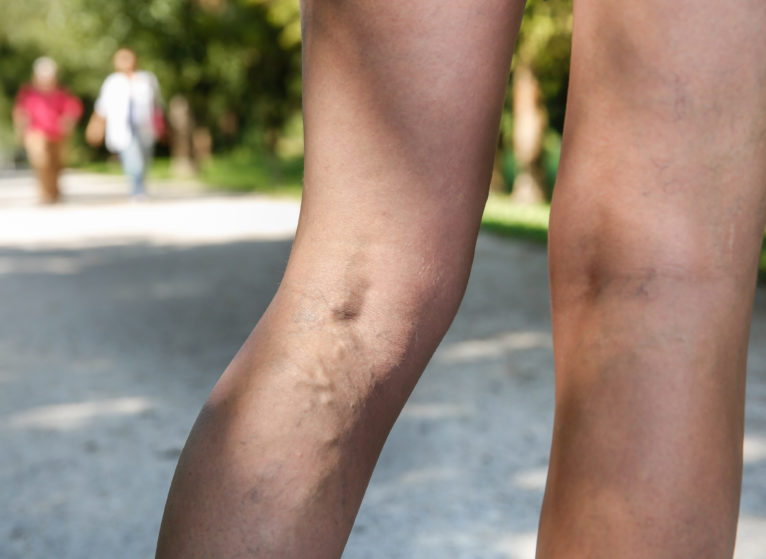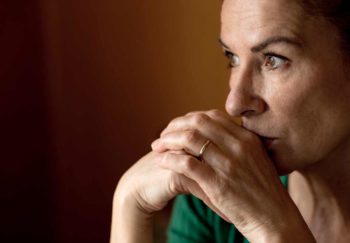If your legs have become a roadmap of tangled blue veins as you have gotten older, you are not alone. According to the American Heart Association, around 80% of men and 85% of women in the U.S. between the ages of 40 and 80 have some type of venous insufficiency, or vein failure, that affects the lower limbs. Two of the most common presentations of venous disease are varicose veins and spider veins. We turned to interventional radiologists J. Fritz Angle, MD, and vascular medicine specialist Aditya Sharma, MD to find out more about them.
FAQs: Varicose Veins vs. Spider Veins
What are varicose veins?
Varicose veins are large, bluish, sometimes-bulging veins visible just below the skin on the legs. They occur when leg veins no longer circulate blood efficiently through the body because of faulty valves, among other reasons. So rather than blood flowing as it should from the legs up to the heart, it pools in the veins, stretching the vein walls and causing varicose veins to appear.
What causes varicose veins?
“In many cases, varicose veins run in families,” says Angle. However, there are some behaviors and traits that can increase your risk, including:
- Pregnancy
- Advanced age
- Obesity
- Standing in place for long periods
How can you prevent varicose veins?
Because varicose veins run in families, it can be a roll of the dice. If your mother, father, or other first-degree relatives have them, your chances of getting them as an adult are high. But staying active, watching your weight, and taking care of your heart can help lower your risk. “Even lightweight, over-the-counter compression stockings may also help slow the development of varicose veins,” adds Angle.
Are varicose veins dangerous?
Some people with varicose veins never experience symptoms. However, others can have significant symptoms, says Sharma. For example, their legs may feel achy, tired, tender, swollen, and heavy after walking. In addition, legs can itch and become discolored. “This condition may not be something people can die from, but it can lead to loss of work, limited mobility, and reduced activity, all of which greatly impact the quality of life.”
When should you seek treatment?
Any time you have symptoms of venous disease, whether you have visible varicose veins or not, Sharma says it’s a good idea to talk to your doctor. They can help you determine the severity of the condition and whether it is necessary to see a vein specialist or seek out additional treatment. “Seeing a doctor sooner rather than later is a good idea because they can help diagnose what is causing the symptoms and tailor treatment accordingly,” he says. In some situations, if left untreated, varicose veins can lead to more advanced chronic venous disease, which may cause open ulcers or blood clots.
What treatments are available for varicose veins?
In most cases, conservative treatment helps resolve symptoms of varicose veins. “Usually, compression stockings will help solve the problem,” says Sharma. However, if symptoms persist, doctors may consider a procedure. There are many methods to get rid of varicose veins; all are minimally invasive outpatient procedures that can be done in one day. They include:
- Endovenous Laser Therapy or EVLT, which uses a small laser to seal off the abnormal veins in the legs, leaving healthy veins to move blood more effectively
- VenaSeal, a medical adhesive that is injected into the vein to close the vein
- Surgery, which is used in rare cases of severe venous disease
“I always make sure patients are aware that varicose veins are a lifelong problem,” adds Angle. “No matter how effective one treatment may be, new varicose veins can appear, so follow-up treatment may be necessary. In addition, if someone presents with a significant number of varicose veins, it may be difficult to get rid of them all in one session.”
Are your varicose veins causing painful symptoms?
It may be time to talk to a vein specialist
What are spider veins?
Spider veins are clusters of thin red or blue lines that appear under the skin in a web-like pattern. “They are typically completely innocuous; they may be very prominent to the eye, but you may not feel them,” says Angle. “Some with spider veins may feel some burning or itching.”
How are varicose veins and spider veins different?
Just like varicose veins, a pooling of blood in non-functional veins causes the appearance of spider veins. However, these veins are smaller, so they are smooth and thread-like compared to the more prominent varicose veins. “Most often, spider veins will not cause any symptoms, but they can depending on the underlying cause,” says Sharma. “If you experience any symptoms — pain, swelling, or other symptoms — you should talk to your doctor.”



I’m 38 years ild and I’m experiencing spider veins and as well as varicose veins and this is what I’ve been dealing with —->. Does varicose veins also cause lumps in upper and lower legs? Cause does varicose veins cause numbness to legs as well?